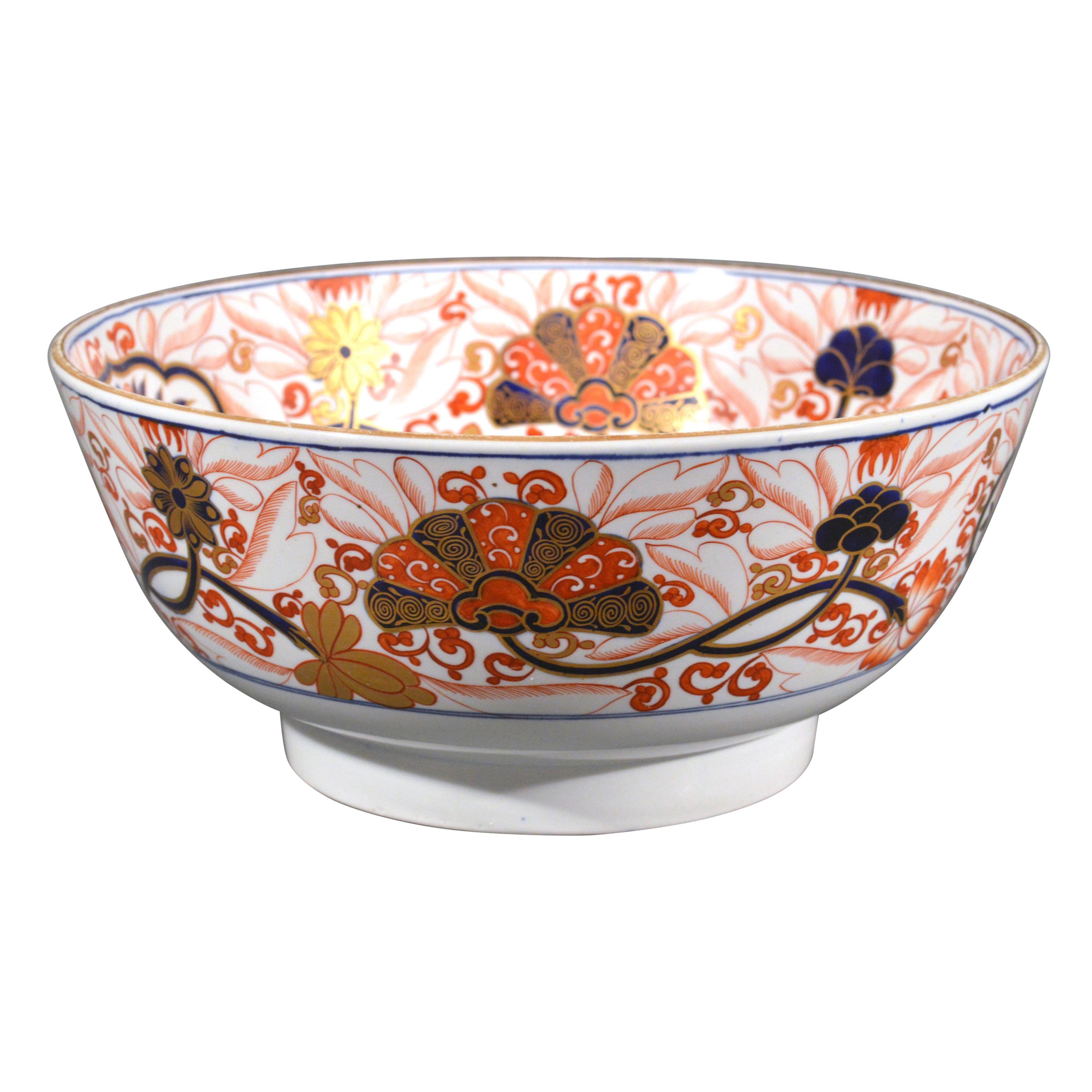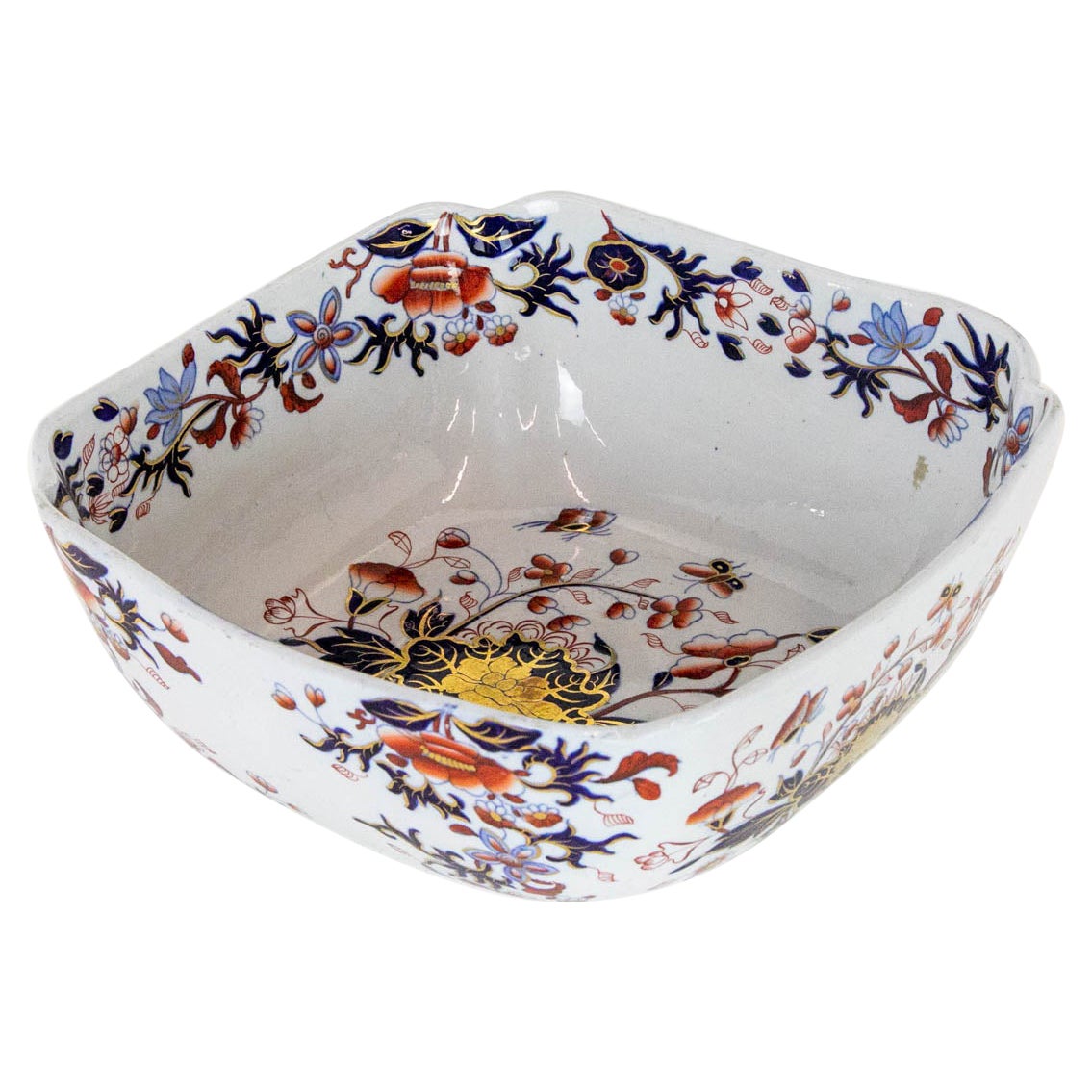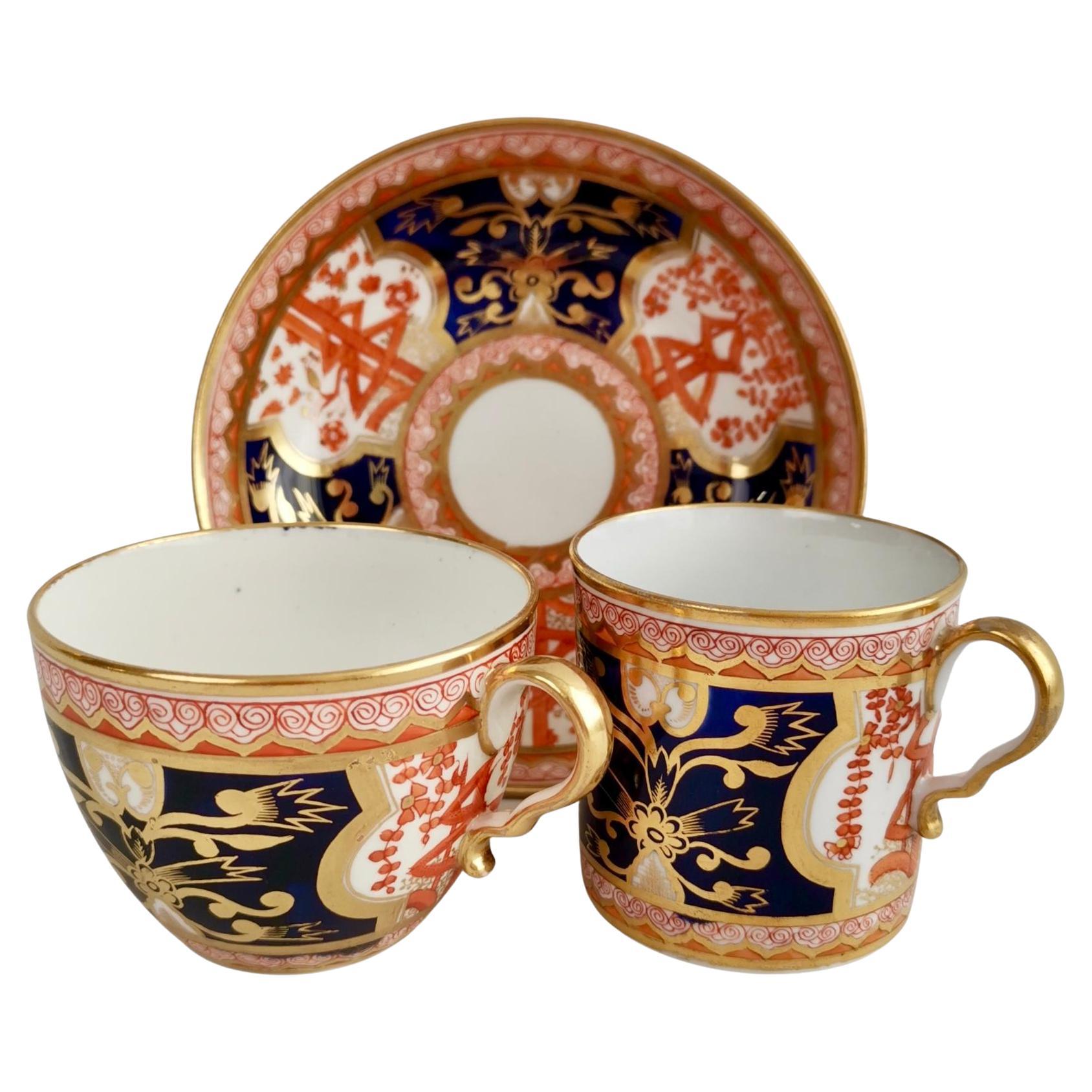Early Spode Regency Dollar Pattern Punch Bowl
About the Item
- Creator:Spode (Maker)
- Dimensions:Height: 4.75 in (12.07 cm)Diameter: 11 in (27.94 cm)
- Style:Regency (In the Style Of)
- Materials and Techniques:
- Place of Origin:
- Period:
- Date of Manufacture:1810-1815
- Condition:Wear consistent with age and use. Some very minor wear to the gilding, most noticeably around the rim and to a small area on the inner golden rim on the bowl. Light scratching to the center of the bowl.
- Seller Location:Fort Lauderdale, FL
- Reference Number:
Spode
Spode is one of the oldest and most distinguished of the great pottery companies of Staffordshire, the time-honored home of English ceramics. The firm’s blue and white bone china transferware is a timeless classic. Spode dishes compose the sort of elegant dinner service that most of us envision on a traditional holiday table.
The company was established in 1770 in Stoke-on-Trent by Josiah Spode, a friend and neighbor of another estimable English ceramist, Josiah Wedgwood. Spode was particularly known for two technical achievements in the firm’s early decades. The first was to develop a standard formula for the making of bone china — a type of porcelain (made with a mixture of bone ash, minerals and clay) that is dazzlingly white and so strong it can be used to create very thin translucent plates and vessels. The other was to perfect the making of transferware. That process involves the transfer of pictorial images inked on tissue paper — such as the garden scenery in the famous Willow dish patterns — onto ceramics that are then sealed with a glaze. In 1833, following the sudden death of Josiah Spode III, business partner W.T. Copeland took over the company and changed its name. Collectors regard Copeland-marked pieces as Spode china. The Spode brand was revived in 1970.
From the 1820s onward, Spode enjoyed tremendous success both in Britain and elsewhere owing to the beauty and vitality of its decorative imagery. By some counts, Spode created more than 40,000 patterns in the 19th century. Many favorite Spode patterns — among them Blue Italian, India Tree, Greek and Woodland — date to the company’s early years. Spode’s most popular pattern, Christmas Tree, was introduced in 1938. Prices for Spode china vary widely, based on the size of the service, its condition and the pattern. An antique dinner service for 12 people or more, in good repair and complete with cups and serving dishes, will generally cost between $10,000 and $20,000. Such Spode services become heirlooms — a proud and timeless addition to a family’s table. And as you will see on these pages, Spode’s rich and varied wares offer a visual feast in and of themselves.
- ShippingRetrieving quote...Ships From: Fort Lauderdale, FL
- Return PolicyA return for this item may be initiated within 2 days of delivery.
- Early Spode Red Greek Pattern TileBy Spode, Josiah SpodeLocated in Fort Lauderdale, FLA Neoclassical red transferware tile made by Spode 1806-1810, with the ‘Refreshments for Phliasian Horseman’ pattern. Sir William Hamilton’s Collection of Etruscan, Greek and Roman antiquities, first published in 1766 by Pierre d’Hancarville, was a landmark publication in English design. It intended to disseminate the Antique style through its engravings of Attic pottery. The catalog’s faithful reproductions of Classical vases led British potteries, including Spode, to adapt or even copy the ancient art for modern life. These Spode Greek pattern tiles reflect the major influence of Hamilton’s catalog on English Neoclassicism. The central scene was taken directly from the catalog. This tile can be dated to a narrow window of production in the Spode factory, 1806-1810. During that time, Spode used a technique known as the “Pluck and Dust” method to print in red transfer designs onto creamware. Using this method, source prints were transferred overglaze using tissue imprinted with a very faint rendition of the design outlined in sticky oil. The decorator applied the tissue to the object then carefully “plucked” or pulled it away, leaving the sticky oil design behind. Then, a finely-ground enamel color was “dusted” onto the surface, sticking to any areas that had the oil. A final firing at a low temperature in the enamel kiln made the pattern permanent. The Pluck and Dust technique improved upon bat-printing and enabled larger designers to be transferred. It was short-lived, however, as under-glaze transfer printing soon took over as the preferred method for producing transferwares. Dimensions: 5 in. x 5 in. x 1/4 in. Condition: Excellent. Slight chip to the upper left corner measuring approximately 0.9 cm. in length. Provenance: The Collection of Nancy and Andrew Ramage Jonathan Horne...Category
Antique Early 19th Century English Neoclassical Pottery
MaterialsEarthenware, Creamware
- Early 19th Century Spode Red Greek Pattern TileBy Spode, Josiah SpodeLocated in Fort Lauderdale, FLA Neoclassical red transferware tile made by Spode 1806-1810, with the ‘Zeus in His Chariot’ pattern. Sir William Hamilton’s Collection of Etruscan, Greek and Roman antiquities, first published in 1766 by Pierre d’Hancarville, was a landmark publication in English design. It intended to disseminate the Antique style through its engravings of Attic pottery. The catalog’s faithful reproductions of Classical vases led British potteries, including Spode, to adapt or even copy the ancient art for modern life. These Spode Greek pattern tiles reflect the major influence of Hamilton’s catalog on English Neoclassicism. The central scene was taken directly from the catalog. This tile can be dated to a narrow window of production in the Spode factory, 1806-1810. During that time, Spode used a technique known as the “Pluck and Dust” method to print in red transfer designs onto creamware. Using this method, source prints were transferred overglaze using tissue imprinted with a very faint rendition of the design outlined in sticky oil. The decorator applied the tissue to the object then carefully “plucked” or pulled it away, leaving the sticky oil design behind. Then, a finely-ground enamel color was “dusted” onto the surface, sticking to any areas that had the oil. A final firing at a low temperature in the enamel kiln made the pattern permanent. The Pluck and Dust technique improved upon bat-printing and enabled larger designers to be transferred. It was short-lived, however, as under-glaze transfer printing soon took over as the preferred method for producing transferwares. Dimensions: 5 in. x 5 in. x 1/4 in. Condition: Excellent. Provenance: The Collection of Nancy and Andrew Ramage Jonathan Horne...Category
Antique Early 19th Century English Neoclassical Pottery
MaterialsEarthenware, Creamware
- Set of 11 Early Spode Ironstone Imari Dessert Dishes Made circa 1815By SpodeLocated in Fort Lauderdale, FLA set of 11 Imari style ironstone dessert dishes, made by Spode circa 1815. Josiah Spode II began producing stone china in 1813 as an alternative to porcelain. Stone china, also kno...Category
Antique Early 19th Century English Regency Dinner Plates
MaterialsIronstone
- Pilkingtons Vermilion Glaze Bowl circa 1930By Pilkington's Royal Lancastrian Pottery CompanyLocated in Fort Lauderdale, FLThis brilliant orange bowl, created by Pilkingtons circa 1930 is dripping with the company's vermilion glaze. It's a fine example of Pilkington’s studio art pottery. Pilkington’s ...Category
Vintage 1930s English Modern Serving Bowls
MaterialsEarthenware
- Mason's Ashworth Orange Chinoiserie Octagonal BowlBy Mason's IronstoneLocated in Fort Lauderdale, FLA Mason’s Ashworth octagonal ironstone bowl decorated in a lively orange glaze with delicate chinoiserie details throughout. The design is transfer-p...Category
Early 20th Century English Chinoiserie Serving Bowls
MaterialsIronstone
- 18th Century Chinese Export Porcelain Punch BowlLocated in Fort Lauderdale, FLA mid-18th century Chinese export porcelain punch bowl, hand-painted with "The Judgement of Paris" after Rubens. European ceramicists borrowed motifs from Chinese porcelains through...Category
Antique 1760s Chinese Chinese Export Decorative Bowls
MaterialsPorcelain
- Regency Spode Imari Punch Bowl, Pattern # 2283By SpodeLocated in Downingtown, PASpode Imari Bowl, Pattern # 2283, Spodes New Stone China, Circa 1815-1820 The beautiful Spode new stone Imari punch bowl is painted in Imari col...Category
Antique Early 19th Century English Regency Barware
MaterialsCeramic
- Spode BowlLocated in Wilson, NCThis bowl has an impressed mark: " Spodes New Stone", and is decorated in the burnt red , white, and blue colors popular in this time period, and has a...Category
Antique 1830s English Serving Bowls
MaterialsIronstone
- Twelve Spode Neo-Classical Greek Pattern Blue Soup PlatesBy SpodeLocated in Downingtown, PASpode Neo-classical Greek pattern blue soup plates, Refreshment for Phliasian Horseman, Set of twelve (12) Early-19th century The Spode Greek pattern ...Category
Antique Early 19th Century English Georgian Pottery
MaterialsPearlware, Pottery
- Spode Pottery Neoclassical Greek Pattern Blue Printed Supper SetBy SpodeLocated in Downingtown, PASpode pottery neoclassical Greek pattern blue printed supper set Early-19th century From a large collection of Greek pattern pieces in various colors ...Category
Antique Early 18th Century English Neoclassical Serving Bowls
MaterialsPearlware, Pottery
- Jewel Pattern Cut Glass Punch Bowl by MeridenBy Meriden Cut Glass CompanyLocated in New Orleans, LAThis two-piece punch bowl and ladle set is cut in one of the rarest and most desirable designs of the American Brilliant Period – Meriden’s sophisticated Jewel pattern. On the bowl, ...Category
Early 20th Century North American Other Glass
MaterialsCut Glass
- Spode Porcelain Teacup Trio, Red Imari Dollar Pattern, Regency, ca 1810By SpodeLocated in London, GBThis is a beautiful orphaned teacup made by Spode in about 1810. It bears a beautiful Japanese-inspired Imari pattern. Spode was the great pioneer among the Georgian potters in England. Around the year 1800 he perfected the bone china recipe that has been used by British potters ever since, and he was also the leading potter behind the technique of transferware, making it possible for English potters to replace the Chinese export china, which had come to an end around that time, with their own designs. This was fundamental to a thriving industry that would last for about 150 years and provide half the world with their tableware. Spode porcelain is regarded as one of the highest quality porcelains around; for a soft-paste porcelain it is surprisingly hard and fine, and has a wonderful bright white colour. The pattern on this can is called "Dollar" pattern, a very famous pattern that was used by English potters in the 18th and early 19th Century. It is obvious why it is called “dollar” - but its origin is less obvious! It is thought that this pattern was derived from a very old Chinese pattern depicting a tree with elaborate foliage that hides a Chinese character representing longevity or happiness. Traditionally, this went with a an image called “Taotie”, which was used on very ancient bronze vases...Category
Antique Early 1800s English Regency Porcelain
MaterialsPorcelain






